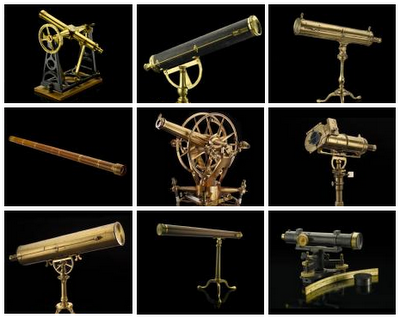Peak Meteor Shower time! Hope everyone is enjoying the Leonids! And what better time to appreciate our telescopes-- which often translates into coveting a newer, better, bigger one.
Conventional history records that German-born Hans Lippershey invented the telescope in 1608, but legend has it that the device was actually invented years earlier by children playing with lenses in his shop where he created eye-spectacles. Other stories say his apprentice first hit upon the idea of doubling refracting lenses. Nonetheless, Lunar Crater Lippershey is named after him, and not the help.
Coastal merchants were the first competitive consumers of early telescopes, using them to spot approaching trade ships; certainly sailors also found them handy when scanning for land masses -- but Galileo Galilei was the first to use one for astronomy. Turning the telescope heavenward, he found the Galilean moons, noted the phases of planet Venus and also analyzed and described sun spots.

Most of the world's largest optical telescopes (listed by aperture) are now built in remote areas, or atop remote peaks, so as to operational in clean, thin air.
For over 70 years, the largest telescope in the world was located at Birr Castle in Ireland. The 40-ton reflecting telescope with a 3-ton mirror, built by the Earl of Rosse in 1845, was nicknamed the “Leviathan of Parsonstown”. Suspended between two giant stone walls, the telescope offered views of Jupiter and one was later used to observe nebulae.

Leviathan
Today, the largest telescope in the world is the Gran Telescopio Canarias (GTC) at the Observatorio del Roque de los Muchachos in La Palma, Canary Islands (Spain).
From 1993 (when fitted with corrective lenses after deployment) to the present, the Hubble Space Telescope has been the source of more than 25% of all published astronomy research papers. Funny how you never hear anyone gripe anymore that it was 7 years late and over-budget.

Radio Telescopes that pick up celestial radio waves instead of light, being all the modern rage, now number over 100 and span the globe. Singular dishes and arrays can be found in both Americas, Europe, Asia, Australia, New Zealand, Africa and Antarctica. There have even been two in space!
The majority of professional astronomers don't even look through eye-pieces anymore. Telescopes are largely operated remotely with computers! Even casual computer users can access robotic observatories from home now. Want to try an internet-based telescope? Go to Seeing In The Dark at Cornell University's Astronomy Department.




